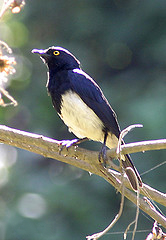Abbott's starling (Arizelopsar femoralis) is a species of starling in the family Sturnidae. It is found in Kenya and Tanzania. Its natural habitat is subtropical or tropical moist montane forests. It is threatened by habitat loss, and its population is estimated at 2500–9999.[2] This species, at 16 to 18 cm (6.3 to 7.1 in) long, is the smallest species of starling.[3] It is in the monotypic genus Arizelopsar.
| Abbott's starling | |
|---|---|

| |
| Male | |

| |
| Female | |
| Scientific classification | |
| Domain: | Eukaryota |
| Kingdom: | Animalia |
| Phylum: | Chordata |
| Class: | Aves |
| Order: | Passeriformes |
| Family: | Sturnidae |
| Genus: | Arizelopsar Oberholser, 1905 |
| Species: | A. femoralis
|
| Binomial name | |
| Arizelopsar femoralis (Richmond, 1897)
| |
| Synonyms | |
|
Pholia femoralis | |
The name of the species commemorates William Louis Abbott (1860-1936), an American naturalist and collector, who studied the wildlife of the Indo-Malayan region.
Diet
editThe Abbott's starling feeds on insects and fruit, including the fruit of Cornus volkensii.[4]
Description
editThe Abbott's starling has a black head and breast with white underparts and a yellow eye. Its voice is a musical whistled call moving up and down the scale.[citation needed]
References
edit- ^ BirdLife International. (2021). "Arizelospar femoralis". IUCN Red List of Threatened Species. 2021: e.T22710787A191046739. doi:10.2305/IUCN.UK.2021-3.RLTS.T22710787A191046739.en.
- ^ "Abbott's Starling (Poeoptera femoralis) - BirdLife species factsheet". datazone.birdlife.org. Archived from the original on 2024-05-27. Retrieved 2018-02-21.
- ^ Starlings & Mynas (Helm Identification Guide) by Chris Feare. A&C Black (1998). ISBN 978-0713639612.
- ^ Craig, Adrian; Feare, C. J. (2020). Del Hoyo, Josep; Elliott, Andrew; Sargatal, Jordi; Christie, David; De Juana, Eduardo (eds.). "Abbott's Starling (Poeoptera femoralis)". www.hbw.com. doi:10.2173/bow.abbsta2.01. S2CID 216305528. Archived from the original on 2024-05-27. Retrieved 2018-02-21.
